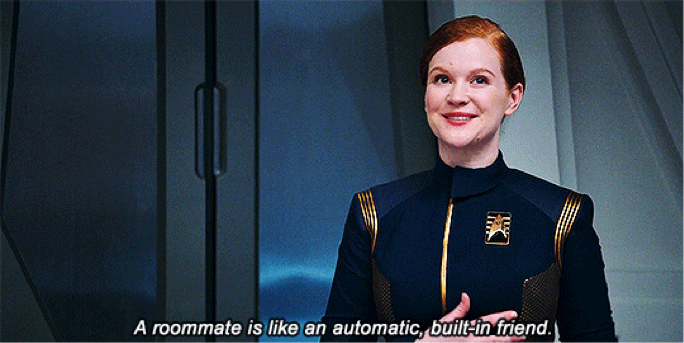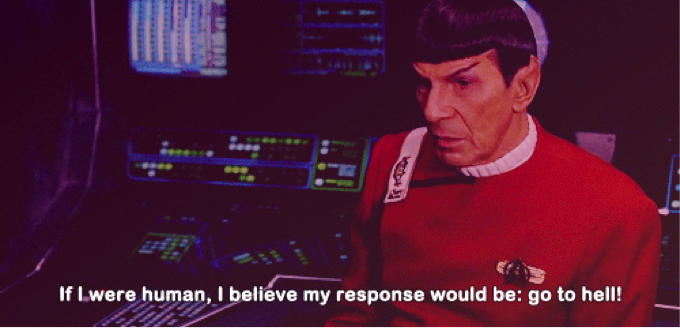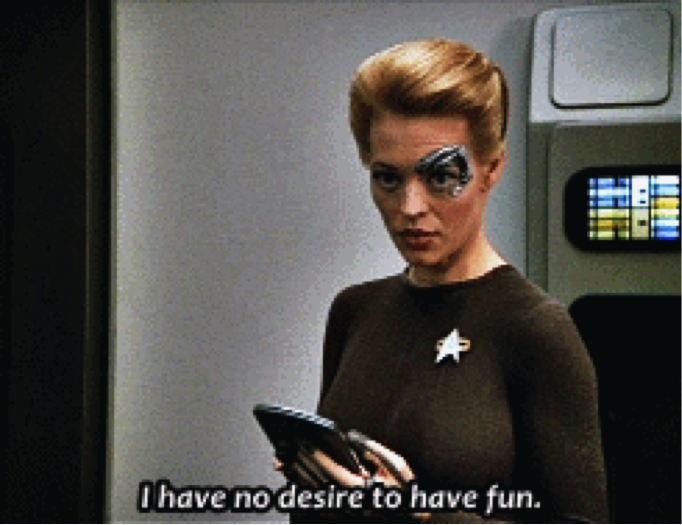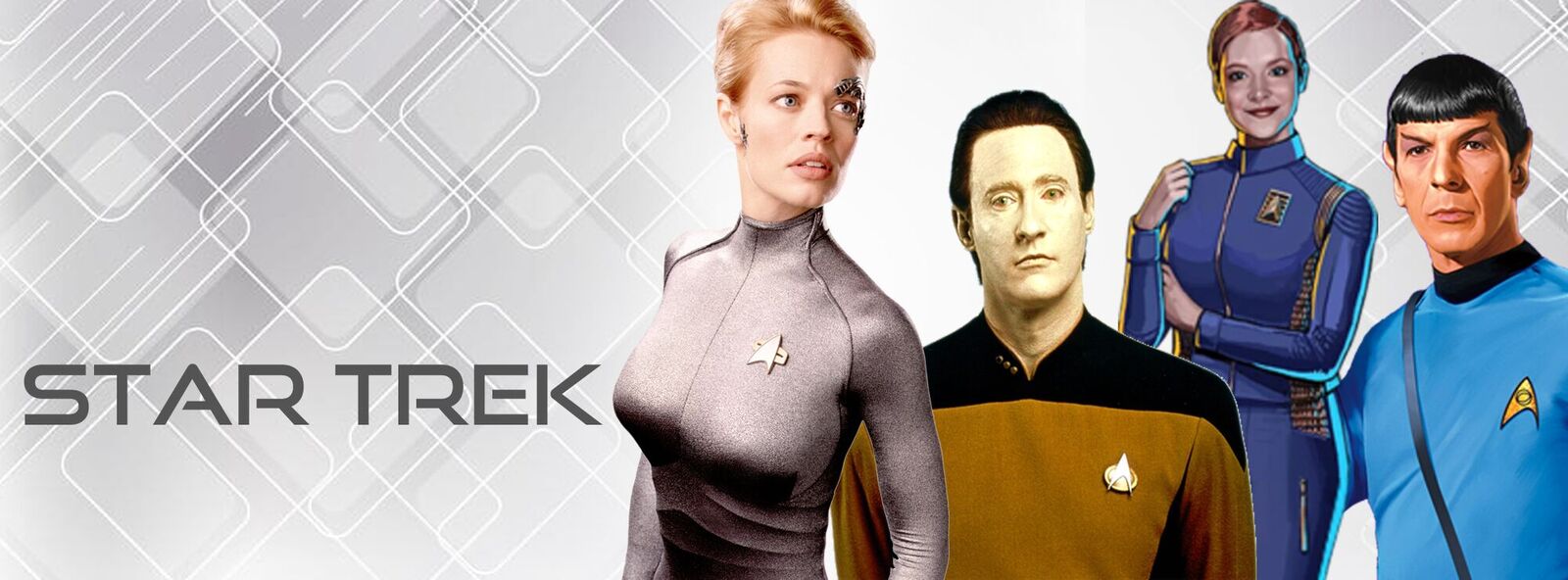After Sesame Street, Star Trek has now also added an autistic looking character to the cast. In the new series, the viewers became acquainted with Sylvia Tilly, beautifully acted by Mary Wisema. Tilly appears to be an ‘Aspergirl’, a woman with Asperger’s syndrome, a form of autism. Why is that? Is Tilly the first ‘Trekkie’ with ‘autistic’ traits? And why is it relevant at all whether there are ‘Aspies’ or other ‘autistic characters’ in Star Trek?
The first episodes of Star Trek (1966-1969) had only a small number of fans, but nowadays the series is widely represented in every conceivable medium. By 2017, Gene Roddenberry’s idea has grown into a successful multimedia franchise with eight television series (one of which is an animated series), thirteen feature films, dozens of computer games and hundreds of books, comic books, technical manuals and encyclopedias. In addition, the Star Trek universe is growing by the minute thanks to the contributions of millions of fans around the world. Whether you’re a Borg or a Klingon, there’s a place for everyone. Also for Cadet Sylvia Tilly (Mary Wiseman), the newest character on board of spacecraft Discovery. Watch as she came to walk into the series, in episode three:
My first impression of Cadet Tilly? She is fun, a bit clumsy, smart, cheerful, beautiful and sits on the autism spectrum. I think the latter because of the four ‘hints’ the scriptwriters gave us about Tilly in this first scene. Firstly, she talks about her “special needs”. Of course, the expression “special needs” can mean anything from a technical point of view, but “special needs” is a loaded term in America, with a specific connotation for today’s viewers. I can’t imagine a team of talented writers using such a concept randomly.
Then it’s about her ‘allergy’ for polyester and viscoelastic polyurethane foam. People with autism have a different ‘stimulus filter’ and are often unable to cope with synthetic substances. Moreover, her comment is emotional, not ‘matter-of-fact-ly’ and businesslike, as you would expect with a normal allergy. Cadet Tilly talks like someone who constantly has to explain and account for what she needs, because her preferences for the outside world seem so arbitrary.

Later in the episode, Tilly also tells us that she always worries too much about what others think of her and her behavior. A typical autistic trait, which is described, for example, in the book Pretending to be Normal (the autobiography of Liane Holliday-Willey, an American woman who found out at the age of 35 that she has Asperger’s syndrome).
Finally, there is her interaction – or the lack of interaction – with Michael. She struggles to feel the atmosphere in the room, rattles in a way that goes beyond general social clumsiness or youthful exuberance and seems to be pausing a little longer to process the emotions in her own way.

Atopos
All people with autism are different, but what they have in common is that they have difficulty with stimuli and communication, exactly the things that Cadet Tilly encounters in this first episode. Does she then have autism? According to cultural scholar Hannah Ebben, it would be better to replace this term with the word atopos.
“Autism comes from the ancient Greek word autos, which means “self”. Autism is defined as a preoccupation with one’s self or being turned inwards. But many people with autism are not turned inwards at all. They are in fact in constant interaction with the space around them. That is why I propose that we speak about atopos. Atopos is the ancient Greek word for “strange”, in the sense that it is unknown in space, or “misplaced”. The medical term atopy, which is derived from atopos, also stands for hypersensitivity to external stimuli and allergic reactions that may arise as a result. This has strong similarities with the over-stimulation that many people with autism suffer from.”
Just as with the many aliens in Star Trek, the behavior of Cadet Tilly is also very similar to the idea of ‘unclassifiable’ or ‘out-of-place’ in other words atopía. At the same time we see a round character. Cadet Tilly has a versatile personality, goals, dreams and hope. In addition, she is really very smart and dedicated. She wants to be a good friend, even though she needs to learn a little extra about how you could tackle something like that. No stereotype, cardboard autistic, and certainly no neurotic Rainman. (Do not get me wrong, Dustin Hoffman is unparalleled in his interpretation of a mentally handicapped person with savant syndrome, but with autism the film has, in my opinion, little to nothing to do). Star Trek sketches a realistic and credible portrait of a gifted young woman with Asperger’s. A relief after the many unrealistic TV autists, who are portrayed as either severely handicapped or brilliant. As less or better than ‘ordinary’ people rather than as a variation within the group of ordinary people.
Thinking back to Captain Pike’s wheelchair (Original Series) and Geordi’s visor (The Next Generation), it is no surprise that Star Trek is committed to the emancipation of people on the autistic spectrum. From the very first (pilot) episode in 1966 to the latest film, Star Trek: Into Darkness, the series has always been socially involved. The lack of understanding between the different personalities with their diverse cultural backgrounds and especially the decisive way in which the Starfleet crew deals with them are a mirror for the viewers. Particularly for viewers belonging to a minority, such as people with disabilities.
Dis-ability? In the Star Trek universe, all humanoid (or android) beings live together in an idyllic paradise, where they are valued for their unique (in)abilities and (in)competencies. In his book An anthropologist on Mars, the famous neurologist Oliver Sacks wrote how “a surprising number of people with autism identify with Data, or with his predecessor, Mr. Spock.” Is that so surprising? In the vision of the future that Star Trek shows us, technology can create more opportunities for people who are still far too often assessed as disabled in our world. A label that viewers wouldn’t easily stick on to a hero like Mr. Spock.

Mr. Spock
Mr. Spock is (biologically speaking half) a so-called Vulcan. The Vulcans were once a barbaric and chaotic people who combined ritual emotional control with the rigid discipline of logic (to prevent their self-destruction). Through this storyline, the Vulcans have actively embraced characteristics that can be experienced by viewers as ‘autistic’. The prejudice that other civilizations in Star Trek place on the Vulcans is therefore very similar to the stigma that neurotypical (non-autistic) people put on people with autism. And that often results in funny dialogues, like this one, from Star Trek: Into Darkness.
Pike: That’s a technicality.
Spock: I am Vulcan, sir. We embrace technicalities.
Pike: Are you giving me attitude, Spock?
Spock: I am expressing multiple attitudes simultaneously. To which are you referring?
Mr. Spock’s journey aboard Starship Enterprise is a journey of self-discovery and acceptance. Supported by his own understanding and that of his colleagues, he repeatedly demonstrates how he uses his autistic qualities to solve a problem. Autistic people often run into prejudice, others often have little understanding for them. This is mainly due to their rigid thinking, literal interpretations, tactlessness, non-conformity and contempt for aimless social interaction. But Mr. Spock’s character shows that it is precisely this background that can help with logical, principled and methodological thinking.
Back to the dialogue from the video. For many people with autism it is incomprehensible why Pike suddenly seems to get angry – after all, Spock has done well, speaks the truth and asks open questions. It’s only in conversation with neurotypical people that it becomes apparent where the misunderstandings lie. In this way Star Trek works as a psycho-education for people for whom the prevailing social norms are not necessarily self-evident. In addition to the “social skills training for advanced”, Spock can be an example of how someone who falls outside the norm can still be appreciated. First of all by himself: Mr. Spock seems completely happy with who and how he is, which can be a consolation for people whose way of thinking is officially a “disorder” and/or “disability”. But also for the environment, to learn to look at what someone with autism can contribute. For although Spock often misunderstands human motives, he is a very intelligent, autonomous and original thinker who sees patterns that others rarely do. He is also a trusted and loyal friend who is greatly appreciated by those around him. As Kirk puts it, ‘I can only say this of my friend: of all the souls I have experienced in my travels, he was the most … human.’ (Star Trek: The Wrath of Khan).
Data
Another character from Star Trek that is often associated with autism is Data, who started out as a supporting role and became one of the most interesting and beloved characters in The Next Generation. Data is often classified as a humanoid robot, but is essentially a cyborg, a creature that consists partly of organic and mechanical parts. Just like people with autism, Data also has a flawed ‘Theory of Mind’, which means that he cannot easily empathize with what someone else thinks or feels. His empathy and compassion go through his intellect – not through his emotion. Unlike Mr. Spock, Data sometimes seems to suffer from the fact that he is not a complete or neurotypical person. Throughout his life, Data is working to get closer to humanity, to become more human. He does this, among other things, by being creative (painting, playing the violin) and by asking people about their emotions. How inconsistent and illogical these are often becomes particularly evident in his romantic interactions with Jenna – full Lieutenant Jenna D’Sora – as in the scene below:
Jenna: The Book of Love, chapter 4, paragraph 17 – ‘when your girlfriend arrives with a gift, stop whatever it is you’re doing and give her your undivided attention’.
Data: I should not have resumed my painting?
Jenna: No.
Data: Despite your suggestion that I continue?
Jenna: Exactly.
Data: I have much to learn.
Data also often interprets sayings and proverbs literally, as shown, for example, by this dialogue:
Data: You have often expressed dissatisfaction with the spartan nature of my quarters. Is this an attempt at embellishment?
Jenna: The cat’s out of the bag.
Data: [looking around for his cat] Spot?
Jenna: No, I mean I… you’ve caught me in the act.
For neurotypical people, Data with dialogues like this may often resemble Captain Oblivious or Captain Obvious, but for people on the autistic spectrum, Data can be an inspiration – just like Spock – an example and consolation. And where Spock shows that you can be happy with yourself, precisely because you are different, Data is there to recognize all the frustrations that being different sometimes entails. For Brent Spiner, the actor who plays Data, that came as a surprise, “One man told me that I was the poster boy for kids with Asperger’s”, he told the website GeekWire. “It really knocks me out when I hear that.”

Seven of Nine
Besides these two characters coded as “male”, there is also the ‘autistic’ and beautiful Seven of Nine. It is a relief for women on the spectrum, who all too often see themselves portrayed as awkward, inelegant, with unkempt hair, and eyeglasses with a broad frame, in inappropriate clothing. Interesting about the character Seven is that she was born as a neurotypical human – with the Scandinavian-like name Annika Hansen – and as a child assimilated by the Borg, a community of cyborgs. Annika became Seven, technically “better” than an average human – and in that process she also became more ‘autistic . According to the writers of the series, Seven was introduced to provide a literary contrast to Kathryn Janeway, just as in the first series Spock was conceived as the counterpart of James T. Kirk, and Data is a beautiful counterpart of Jean-Luc Picard.
Janeway takes care like a mother over Seven and wants to help her to (re)find her humanity. How difficult that sometimes is appears as scenes as the one below, in which Janeway tries to explain to Seven the unwritten rules for small-talk. Seven follows them up exactly, but in a way that does not fit in with the (other) people. Just like Spock and Data, she remains a misfit, atopos.
Janeway: Having fun?
Seven: No.
Janeway: That’s probably because you’ve been standing here by yourself.
Seven: l don’t understand the rules and procedures for this type of social occasion.
Janeway: The rules are simple. Choose a group of people. Listen to their conversation. Then when you feel like you have something to contribute, chime in.
Seven: “Chime in”?
Janeway: You say something. Join the discussion.
Seven: l will try, Captain.
The Doctor: The early stages of Ktarian development are astounding. Naomi has grown five centimeters since her last physical and that was only three weeks ago.
Samantha: lt seems like every time l turn around, l’m recycling her clothes back into the replicator.
Seven: Children assimilated by the Borg are placed in maturation chambers for 17 cycles.
>[awkward silence]
Samantha: …interesting. Well, if you’ll excuse me, l need to go talk to Neelix.
The Doctor: ln these maturation chambers, the development of conversational skills is, l suppose, a low priority?

Conclusions?
Diagnosing fictitious persons is a tricky business, but as they present themselves, all three characters would probably score high on the AQ test. The Vulcan Mr. Spock and the cyborgs Data and Seven of Nine are very similar in their behavior and way of thinking to people with autism. And Cadett Tilly is the first (complete) person in the series who reminds us of an Aspergirl. She clearly adds something to the cast and at the same time fits into the tradition of “autistic characters” in the series. Tilly is not atopos at all in Star Trek, but is perfectly in place. Did the Star Trek writers deliberately give some characters ‘autistic’ traits? Maybe. But in the early 90s, when Data was created, there was even less knowledge about autism than there is today. And for Brent Spiner, the perception came as a surprise. It could therefore simply be a coincidence. Of course, the creators of the series also cater to their audience: from The Original Series to Discovery, Star Trek is especially appreciated by highly educated people with an interest in gadgets and thought experiments. According to a large forum for Trekkies and Trekkers, a high percentage of viewers see themselves as nerd and/or geek. To my knowledge, it has never been researched, but I would not be surprised if there were a higher percentage of people with autism and autistic traits among Star Trek fans than average. For all those people, the fandom of Star Trek has many very attractive aspects: collecting, dressing up and learning languages like Klingon… and role models like Spock, Data, Seven or Nine and the latest addition Cadet Tilly.
This blog was originally written in Dutch, for Teeveehoek.nl
